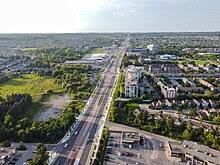Introduction:
Yonge Street is one of Ontario, Canada's most iconic and historically significant thoroughfares. It holds a special place in the hearts of Ontarians and Canadians alike due to its rich history and central role in the province's development. In this overview, we'll explore the history, location, cities connected, benefits, drawbacks, current status, future development, recommendations, and frequently asked questions about Yonge Street.
History:
Yonge Street, named after Sir George Yonge, was initially constructed in the late 18th century as a military road to connect Lake Ontario at Toronto with Lake Simcoe and Georgian Bay to the north. It played a vital role in the colonization and development of Upper Canada (now Ontario) and became an essential trade route for settlers, fostering the growth of towns along its path.
Location:
Yonge Street extends approximately 1,896 kilometers (1,178 miles) through southern Ontario, making it one of the longest streets in the world. It starts at the Toronto Lakeshore and heads north through the city of Toronto, then continues through numerous municipalities and regions, eventually reaching Innisfil, near Lake Simcoe.
Cities Connected:
Yonge Street connects several major cities and communities, including Toronto, North York, Richmond Hill, Aurora, Newmarket, and Barrie. It has served as a vital transportation corridor linking these urban centers and facilitating economic activity and regional development.
Benefits:
- Historical Significance: Yonge Street has deep historical roots, playing a pivotal role in Ontario's development and the growth of many towns and communities along its path.
- Transportation: It serves as a major transportation artery, reducing travel times and facilitating the movement of people and goods between key cities.
- Economic Activity: The street has fostered economic development along its route, attracting businesses and residents alike.
- Cultural Landmarks: It is home to numerous cultural landmarks, including theaters, shops, and restaurants, making it a vibrant and diverse cultural hub.
Drawbacks:
- Traffic Congestion: Yonge Street, particularly in Toronto, is known for its traffic congestion, leading to delays and increased commute times.
- Infrastructure Challenges: Aging infrastructure and the need for maintenance pose challenges for keeping the street in good condition.
- Urban Sprawl: The growth of suburban communities along Yonge Street has contributed to urban sprawl, leading to environmental concerns and increased pressure on infrastructure.
Current Status:
Yonge Street remains a bustling and vital thoroughfare. Efforts are ongoing to improve its infrastructure and address congestion issues. The street continues to serve as a cultural and economic center for the region.
Future Development:
Future development plans for Yonge Street include improving public transportation, enhancing pedestrian and cyclist infrastructure, and revitalizing urban areas to promote sustainable growth while preserving its historical character.
Recommendations:
Invest in Public Transportation: Expanding and improving public transportation options along Yonge Street can help alleviate traffic congestion and reduce environmental impact.
Heritage Preservation: Continue efforts to preserve and celebrate the historical significance of Yonge Street, ensuring its legacy endures.
Mixed-Use Development: Encourage mixed-use development to create vibrant and walkable communities along the street.
Environmental Sustainability: Implement environmentally friendly initiatives to address the challenges posed by urban sprawl and increase green spaces.
Conclusion:
Yonge Street, with its storied history and significant role in Ontario's development, remains a vital and iconic thoroughfare. While it faces challenges, careful planning and investment in infrastructure can ensure its continued importance in the region's future.
FAQs:
1. Is Yonge Street the longest street in the world?
Yonge Street is often claimed as one of the longest streets in the world, although this claim is debated. It is indeed one of the longest streets in Canada.
2. What are some notable landmarks along Yonge Street?
Some notable landmarks include the Eaton Centre, Massey Hall, and the Ontario Legislative Building in Toronto.
3. How is Yonge Street addressing traffic congestion?
Efforts include expanding public transportation options, implementing traffic management strategies, and exploring road improvements.
4. What is the historical significance of Yonge Street?
Yonge Street played a crucial role in the development of Upper Canada (Ontario) by serving as a key trade and transportation route for early settlers and traders.
5. Are there plans for extending Yonge Street further north?
While there have been discussions about extending Yonge Street further north, there are no concrete plans for such an extension at this time.



.png)
No comments:
Post a Comment